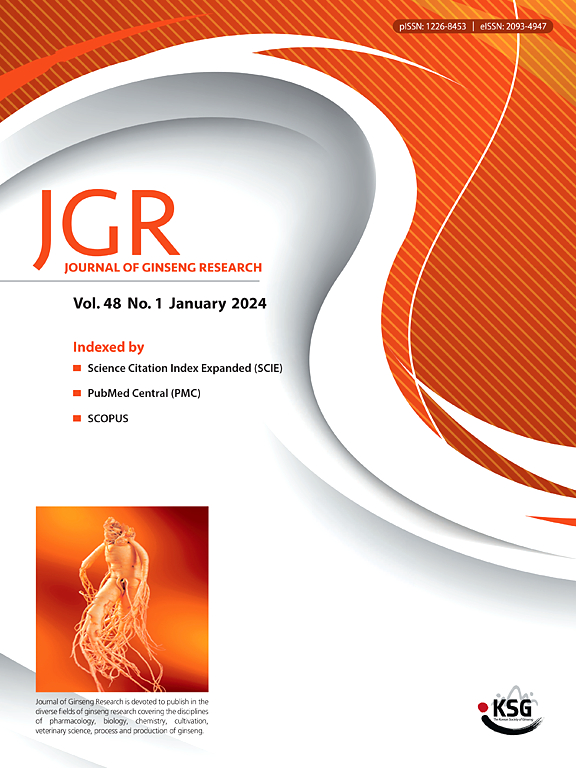人参皂苷Rh2通过ROS/MAPK14信号通路减轻脊髓损伤小鼠炎症反应,促进运动功能恢复
IF 6.8
2区 医学
Q1 CHEMISTRY, MEDICINAL
引用次数: 0
摘要
背景抑制神经系统炎症是脊髓损伤治疗的重要组成部分。植物源性化合物可减轻脊髓损伤,恢复神经功能,阻断炎症反应。人参中的20(S)-人参皂苷Rh2 (G-Rh2)具有抗炎特性,通过激活MAPK通路抑制MAPK14蛋白的表达。因此,本研究通过细胞和动物模型探讨G-Rh2对脊髓损伤的抗炎作用。方法为了探索G-Rh2在脊髓损伤中的抗炎作用,我们采用生物信息学分析方法预测G-Rh2与脊髓损伤相关的靶蛋白和信号通路。我们利用BV2小胶质细胞模拟脂多糖(LPS)诱导的炎症,并在小鼠脊髓损伤模型中采用改良的Allen’s技术。我们的研究使用了一系列方法,包括定量实时聚合酶链反应(qRT-PCR)、酶联免疫吸附试验(ELISA)、免疫荧光(IF)和Western Blot (WB)。结果生物信息学分析和分子对接鉴定MAPK14为G-Rh2的关键靶点。在BV2细胞实验中,G-Rh2降低炎症因子、活性氧(ROS)和MAPK信号通路相关转录因子的表达和生成。G-Rh2在使用改良Allen入路治疗脊髓损伤的小鼠模型中显示炎症反应减少和运动功能改善。结论- rh2通过ROS/MAPK14信号通路减轻脊髓损伤小鼠的炎症反应,促进运动功能恢复。本文章由计算机程序翻译,如有差异,请以英文原文为准。

Ginsenoside Rh2 alleviates inflammatory response and enhances motor function recovery in spinal cord injury mice via the ROS/MAPK14 signaling pathway
Background
Inhibiting inflammation in nervous system is a vital part of treating for spinal cord injury (SCI). Compounds originating from plants can decrease the damage in the spinal cord for recovering the function of nerve and interrupting the inflammatory reaction. 20(S)-Ginsenoside Rh2 (G-Rh2) from Panax ginseng is an anti-inflammatory property inhibiting the expression of MAPK14 protein by enabling the MAPK pathway. Therefore, this research explored the anti-inflammatory effects of G-Rh2 on SCI using cellular and animal models.
Methods
To explore G-Rh2's anti-inflammatory potential in SCI, we employed bioinformatics analysis to anticipate target proteins and signaling pathways associated with G-Rh2 and SCI. We utilized BV2 microglia cells to model inflammation induced by lipopolysaccharide (LPS), and a modified Allen's technique in a mouse SCI model. Our investigation utilized a range of methodologies including quantitative real-time polymerase chain reaction (qRT-PCR), Enzyme-Linked Immunosorbent Assay (ELISA), Immunofluorescence (IF) and Western Blot (WB).
Results
Bioinformatics analysis and molecular docking identified MAPK14 as a key target of G-Rh2. In BV2 cells experiments, G-Rh2 reduced the expression and generation of inflammatory factors, reactive oxygen species (ROS), and transcription factors involved in the MAPK signaling pathway. G-Rh2 showed a decrease in inflammatory reaction and improvements in motor function in the mouse model using the modified Allen's approach for SCI.
Conclusion
G-Rh2 mitigates inflammatory responses and enhances motor function recovery in mice with SCI via the ROS/MAPK14 signaling pathway.
求助全文
通过发布文献求助,成功后即可免费获取论文全文。
去求助
来源期刊

Journal of Ginseng Research
CHEMISTRY, MEDICINAL-INTEGRATIVE & COMPLEMENTARY MEDICINE
CiteScore
11.40
自引率
9.50%
发文量
111
审稿时长
6-12 weeks
期刊介绍:
Journal of Ginseng Research (JGR) is an official, open access journal of the Korean Society of Ginseng and is the only international journal publishing scholarly reports on ginseng research in the world. The journal is a bimonthly peer-reviewed publication featuring high-quality studies related to basic, pre-clinical, and clinical researches on ginseng to reflect recent progresses in ginseng research.
JGR publishes papers, either experimental or theoretical, that advance our understanding of ginseng science, including plant sciences, biology, chemistry, pharmacology, toxicology, pharmacokinetics, veterinary medicine, biochemistry, manufacture, and clinical study of ginseng since 1976. It also includes the new paradigm of integrative research, covering alternative medicinal approaches. Article types considered for publication include review articles, original research articles, and brief reports.
JGR helps researchers to understand mechanisms for traditional efficacy of ginseng and to put their clinical evidence together. It provides balanced information on basic science and clinical applications to researchers, manufacturers, practitioners, teachers, scholars, and medical doctors.
 求助内容:
求助内容: 应助结果提醒方式:
应助结果提醒方式:


